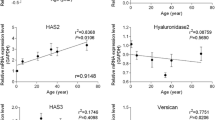Abstract
Cultured normal human fibroblasts during in vitro aging exhibited increased proportions of heparan sulfate (HS; a glycosaminoglycan (GAG) species) in the cell-associated GAG pool, coincident with decreased cell growth activity. An analysis of GAG metabolism demonstrated that human fibroblasts during aging became relatively rich in HS due to an alteration in the profile of GAG synthesis. HS became relatively enriched and hyaluronic acid (HA) relatively depleted through a decrease in HA synthase activity. An experimental enrichment of human fibroblast cultures with exogenous HS brought about an arrest of the cells in the G0/G1 phase and a decrease in the rate of S phase entry, coincident with aged cell growth behaviour. These results suggest that the change in HA synthesis is responsible, at least to some extent, for the growth reduction during aging of normal human fibroblasts.
Similar content being viewed by others
References
Hayflick L.: The limited in vitro lifetime of human diploid cell strains. Exp. Cell. Res. 37: 614–636, 1965.
Smith J.R., Lincoln II D.W.: Aging of cells in culture. Int. Rev. Cytol. 89: 151–177, 1984.
Sluke G., Schachtschabel D.O., Wever J.: Age-related changes in the distribution pattern of glycosaminoglycans synthesized by cultured human diploid fibroblasts (WI-38). Mech. Ageing Develop. 16: 19–27, 1981.
Matuoka K., Mitsui Y.: Changes in cell-surface glycosaminoglycans in human diploid fibroblasts during in vitro aging. Mech. Ageing Develop. 15: 153–163, 1981.
Matuoka K., Mitsui Y.: Involvement of cell surface heparan sulfate in the density-dependent inhibition of cell proliferation. Cell Struct. Funct. 6: 23–33, 1981.
Fritze L.M.S., Reilly C.F., Rosenberg R.D.: An antiproliferative heparan sulfate species produced by postconfluent smooth muscle cells. J. Cell. Biol. 100: 1041–1049, 1985.
Ishihara M., Fedarko N.S., Conrad H.E.: Involvement of phosphatidylinositol and insulin in the coordinate regulation of proteoheparan sulfate metabolism and hepatocyte growth. J. Biol. Chem. 262: 4708–4716, 1987.
Gallagher J.T., Lyon M., Steward W.P.: Structure and function of heparan sulfate proteoglycans. Biochem. J. 236: 313–325, 1986.
Schachtschabel D.O., Sluke G.: Increase of cellular hyaluronic acid synthesis following continuous exposure of cultured human fibroblasts (WI-38) to hydrocortisone. Z. Gerontol. 19: 173–178, 1986.
Matuoka K., Namba M., Mitsui Y.: Hyaluronate synthetase inhibition by normal and transformed human fibroblasts during growth reduction. J. Cell. Biol. 104: 1105–1115, 1987.
Ohashi M., Aizawa S., Ooka H.: A new human diploid cell strain, TIG-1, for the research on cellular aging. Exp. Gerontol. 14: 121–133, 1980.
Namba M., Nishitani K., Kimoto T.: Characteristics of WI-38 cells (WI-38 CT-1) transformed by treatment with Co-60 gamma rays. Gann (Jpn. J. Cancer Res.) 71: 300–307, 1980.
Matuoka K., Mitsui Y., Murota S.: Heparan sulfate enhances growth of transformed human fibroblasts. Cell Struct. Funct. 9: 357–367, 1984.
Smith J.A., Martin L.: Do cells cycle? Proc. Natl. Acad. Sci. USA 70: 1263–1267, 1973.
Matuoka K., Mitsui Y., Murota S.: Growth-coupled changes in glucosaminoglycans (heparan sulfate and hyaluronic acid) in normal and transformed human fibroblasts. Cell. Biol. Int. Rep. 9: 577–586, 1985.
Fried J., Perez A.G., Glarkson B.D.: Flow cytometric analysis of cell cycle distribution using propidium iodide. Properties of the method and mathematical analysis of the data. J. Cell. Biol. 71: 172–181, 1976.
Macieira-Coelho A.: Changes in membrane properties associated with cellular aging. Int. Rev. Cytol. 83: 183–220, 1983.
Tomida M., Koyama H., Ono T.: Induction of hyaluronic acid synthetase activity in rat fibroblasts by medium change of confluent cultures. J. Cell. Physiol. 86: 121–130, 1975.
Moscatelli D., Rubin H.: Hormonal control of hyaluronic acid production in fibroblasts and its relation to nucleic acid and protein synthesis. J. Cell Physiol. 91: 79–88, 1977.
Matuoka K., Mitsui Y., Murota S., Namba M.: Actions of exogenous heparan sulfate and hyaluronic acid on growth and thymidine incorporation of normal and transformed human fibroblasts. Cell. Biol. Int. Rep. 9: 815–824, 1985.
Schachtschabel D.O., Wever J., Sluke G., Wever G.: Influence of exogenous glycosaminoglycans on growth and glycosaminoglycan synthesis of cultured human diploid fibroblasts (WI-38). Z. Gerontol. 12: 19–26, 1979.
Wever J., Schachtschabel D.O., Sluke G., Wever G.: Effect of short- or long-term treatment with exogenous glycosaminoglycans on growth and glycosaminoglycan synthesis of human fibroblasts (WI-38) in culture. Mech. Ageing Develop. 14: 89–99, 1980.
Griffiths T.D.: S-phase transit times as a function of age in human diploid fibroblasts. Mech.Ageing Develop. 24: 273–282, 1984.
Cunningham D.D., Remo R.A.: Specific increase in ribonucleic acid synthesis in 3T3 mouse cells. J. Biol. Chem. 248: 6282–6288, 1973.
Grove G.L., Cristofalo V.J.: Characterization of the cell cycle of cultured human diploid cells: Effects of aging and hydrocortisone. J. Cell. Physiol. 90: 415–422, 1977.
Rittling S.R., Brooks K.M., Cristofalo V.J., Baserga R.: Expression of cell cycle-dependent genes in young and senescent WI-38 fibroblasts. Proc. Natl. Acad. Sci. USA 83: 3316–3320, 1986.
Gorman S.D., Cristofalo V.J.: Analysis of the G1 arrest position of senescent WI38 cells by quinacrine dihydrochloride nuclear fluorescence. Evidence for a late G1arrest. Exp. Cell. Res. 167: 87–94, 1986.
Macieira-Coelho A.: Action of cortisone on human fibroblasts in vitro. Experimentia 22: 390–391, 1966.
Mian N.: Characterization of a high-Mr plasma-membrane-bound protein and assessment of its role as a constituent of hyaluronate synthase complex. Biochem. J. 237: 343–357, 1986.
Author information
Authors and Affiliations
Rights and permissions
About this article
Cite this article
Matuoka, K., Hasegawa, N., Namba, M. et al. A decrease in hyaluronic acid synthesis by aging human fibroblasts leading to heparan sulfate enrichment and growth reduction. Aging Clin Exp Res 1, 47–54 (1989). https://doi.org/10.1007/BF03323875
Received:
Accepted:
Published:
Issue Date:
DOI: https://doi.org/10.1007/BF03323875




